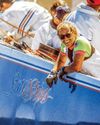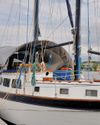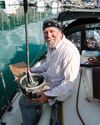
For years, I've been touting the advantages of 24-volt DC systems on boats. Higher voltage equates to lower current and less electrical resistive loss in an onboard electrical system. Boatbuilders say that the primary reason they have not adopted 24 or higher voltages is a lack of available components. Well, rest assured, that is rapidly changing.
As with many marine systems, much of what we see on boats gets its start in much larger industry sectors, primarily automotive and recreational vehicles. In this case, the movement to all-electric or hybrid-electric propulsion systems in cars and light trucks is a primary driving force. Consumer demand for onboard equipment with functionality similar to a new Audi or Tesla plays a part as well. So, with that said, let's look at where we are today, and at how to think about upgrades on an older boat or accessory choices on a new one.
ELECTRICAL FUNDAMENTALS
One big worry about cruising boats and their wiring has to do with voltage drop, where battery-level voltage doesn't actually reach the appliance the battery is supplying. Boats will often have longer wire runs than automotive applications. All wire has some inherent electrical resistance that will lower the voltage at the appliance. This is acceptable, to a point.
The American Boat and Yacht Council and the International Standards Organization identify two levels of acceptable voltage drop for battery-powered direct current (DC) systems: 3 percent and 10 percent. The bigger the wire diameter, the less inherent resistance it will have. As for voltage, higher voltages mean that lower amperage is required to achieve the same level of power (watts).
この記事は Cruising World の August 2023 版に掲載されています。
7 日間の Magzter GOLD 無料トライアルを開始して、何千もの厳選されたプレミアム ストーリー、9,000 以上の雑誌や新聞にアクセスしてください。
すでに購読者です ? サインイン
この記事は Cruising World の August 2023 版に掲載されています。
7 日間の Magzter GOLD 無料トライアルを開始して、何千もの厳選されたプレミアム ストーリー、9,000 以上の雑誌や新聞にアクセスしてください。
すでに購読者です? サインイン

Off Watch
A1A is not only my favorite Jimmy Buffett album, but it's one of my favorite records ever. If I were marooned on an island and could bring only five CDs with me, this would be one of them

PREPARING A VESSEL FOR SURVEY
Trying to hide a boat's problems never ends well for the seller. Follow these tips to have a successful day

THE WESTERN WAY
Instead of buying a pricey custom canvas awning for my schooner, I made my own \"covered wagon.\"

HIDDEN GEM
BUT ALL AROUND IS A PARADISE FOR SAILORS WHO LOVE TO LINGER AND EXPLORE

Last Man Standing
During the past four decades, the once-thriving business of American production sailboat manufacturing has nearly vanished, and dozens of companies and builders have fallen by the wayside. And then there's Tartan Yachts of northeast Ohio, which, in some aspects, is as vibrant as ever. Longtime Tartan stalwart Tim Jackett, a marine-industry lion in winter still making a stand, might be the central reason why

Boat of the Year 2024
With sweet, early autumn sailing conditions on Chesapeake Bay, a strong fleet of 19 contenders competed for top honors in our annual Boat of the Year competition. Once the spray had settled and the votes were tallied, the judges awarded prizes in seven categories for monohulls and multihulls. The overall winner? The surprising, innovative Jeanneau Yachts 55.

On Watch
Sometimes, a seamanship or safety issue requires sailors to give up and turn around. But other times, it's just fear taking control of a situation that can be handled

Sailor & Galley
This rich, steaming stew from the Pacific Northwest warms chilled sailors' bones and brings back a lifetime of memories.

Seamanship
George Eldridge first published the Eldridge Tide and Pilot Book in 75. Its new edition, published by the sixth generation of his family, is an impressive feat of continuity

Island Time
It's impossible to rank these favorite destinations by beauty. Instead, sailors should set a waypoint based on what they want to experience